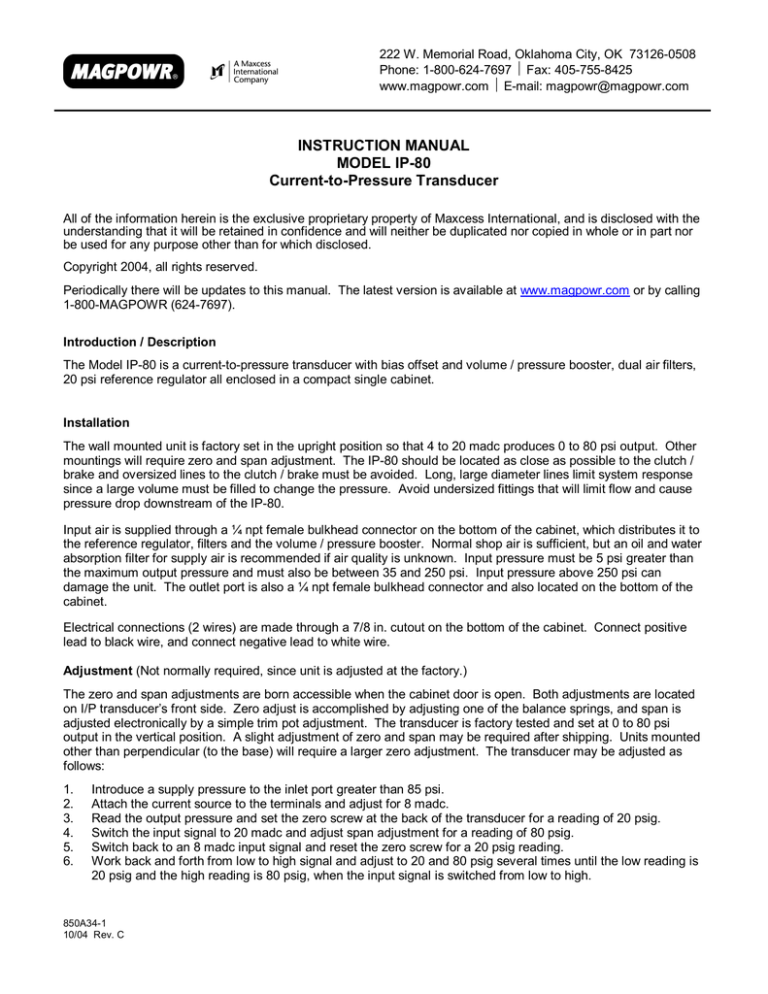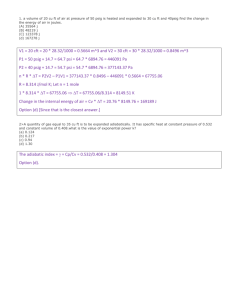
222 W. Memorial Road, Oklahoma City, OK 73126-0508
Phone: 1-800-624-7697 Fax: 405-755-8425
www.magpowr.com E-mail: magpowr@magpowr.com
INSTRUCTION MANUAL
MODEL IP-80
Current-to-Pressure Transducer
All of the information herein is the exclusive proprietary property of Maxcess International, and is disclosed with the
understanding that it will be retained in confidence and will neither be duplicated nor copied in whole or in part nor
be used for any purpose other than for which disclosed.
Copyright 2004, all rights reserved.
Periodically there will be updates to this manual. The latest version is available at www.magpowr.com or by calling
1-800-MAGPOWR (624-7697).
Introduction / Description
The Model IP-80 is a current-to-pressure transducer with bias offset and volume / pressure booster, dual air filters,
20 psi reference regulator all enclosed in a compact single cabinet.
Installation
The wall mounted unit is factory set in the upright position so that 4 to 20 madc produces 0 to 80 psi output. Other
mountings will require zero and span adjustment. The IP-80 should be located as close as possible to the clutch /
brake and oversized lines to the clutch / brake must be avoided. Long, large diameter lines limit system response
since a large volume must be filled to change the pressure. Avoid undersized fittings that will limit flow and cause
pressure drop downstream of the IP-80.
Input air is supplied through a ¼ npt female bulkhead connector on the bottom of the cabinet, which distributes it to
the reference regulator, filters and the volume / pressure booster. Normal shop air is sufficient, but an oil and water
absorption filter for supply air is recommended if air quality is unknown. Input pressure must be 5 psi greater than
the maximum output pressure and must also be between 35 and 250 psi. Input pressure above 250 psi can
damage the unit. The outlet port is also a ¼ npt female bulkhead connector and also located on the bottom of the
cabinet.
Electrical connections (2 wires) are made through a 7/8 in. cutout on the bottom of the cabinet. Connect positive
lead to black wire, and connect negative lead to white wire.
Adjustment (Not normally required, since unit is adjusted at the factory.)
The zero and span adjustments are born accessible when the cabinet door is open. Both adjustments are located
on I/P transducer’s front side. Zero adjust is accomplished by adjusting one of the balance springs, and span is
adjusted electronically by a simple trim pot adjustment. The transducer is factory tested and set at 0 to 80 psi
output in the vertical position. A slight adjustment of zero and span may be required after shipping. Units mounted
other than perpendicular (to the base) will require a larger zero adjustment. The transducer may be adjusted as
follows:
1.
2.
3.
4.
5.
6.
Introduce a supply pressure to the inlet port greater than 85 psi.
Attach the current source to the terminals and adjust for 8 madc.
Read the output pressure and set the zero screw at the back of the transducer for a reading of 20 psig.
Switch the input signal to 20 madc and adjust span adjustment for a reading of 80 psig.
Switch back to an 8 madc input signal and reset the zero screw for a 20 psig reading.
Work back and forth from low to high signal and adjust to 20 and 80 psig several times until the low reading is
20 psig and the high reading is 80 psig, when the input signal is switched from low to high.
850A34-1
10/04 Rev. C
Specifications
Output:
Maximum supply pressure:
Input:
Minimum supply pressure:
Flow Capacity:
Exhaust Capacity:
Shock and Vibration Effect
on Output Pressure:
Brake Pressure Gage:
Filters (2):
0 to 80 psi
250 psi
4 to 20 madc
5 psi above maximum required, 35 psi minimum
40 scfm at 100 psi supply and 20 psi set
0.5 scfm at downstream pressure
5 psi above set point
Negligible at 4 G between 5 to 200 Hz
2 in. dial, 0 to 100 psi
3 micron with automatic drain
0.01 micron with automatic drain
Maintenance
The dripwell is drained automatically on both filters depending upon the flow through the filters and
pressure drop in the filters.
To change a filter element, unscrew metal bowl, remove element retainer; element can now be removed.
Place new element on retainer and place whirl disc on top of the element. Screw retainer back into head
making sure whirl disc fits over shoulder on head. Screw bowl into head hand tight. Bowl can be
cleaned in kerosene, gasoline or similar solvent.
Recommended replacement of the filter element is once a year under normal supply air condition. More
frequent replacement required if the supply air contains a significant amount of oil or water.
Repair
It is recommended that transducer section failures be returned to the factory for repair. But in the case
when internal clogging occurs due to improper filtering of the supply air, the orifice can be cleaned
without removing the unit from its mounting or plumbing. Turn off the supply air. Unscrew and remove
the orifice assembly. Clean the orifice through the side of the orifice assembly using a wire that has a
smaller diameter than 0.015 in. Shake out any loose particles inside of the orifice assembly. Screw
orifice assembly back into unit.
Wiring Diagram
2
Dimensions
1.00 [24 mm]
6.000 [152.4 mm]
(4) .313 [8.0 mm] DIA.THRU HOLES
11.50 [292 mm]
10.750 [273.0 mm]
10.00 [244 mm]
.63 [16 mm]
1.75 [44 mm]
AIR OUT
.88 [22 mm]
1.81 [46 mm]
.50 [13 mm]
AIR IN
1.16 [28 mm]
3.97 [101 mm]
7.00 [178 mm]
8.00 [203 mm]
2.91 [74 mm]
4.38 [111 mm]


